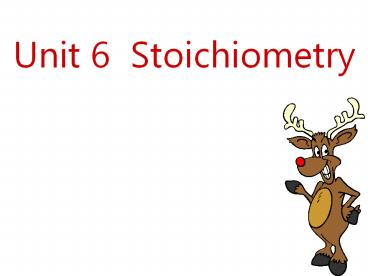Unit 6 Stoichiometry - PowerPoint PPT Presentation
Title:
Unit 6 Stoichiometry
Description:
Unit 6 Stoichiometry What Exactly Is Stoichiometry? Composition stoich ... How many grams of SnF2 are produced from the reaction of 30.00 g of HF with Sn? – PowerPoint PPT presentation
Number of Views:237
Avg rating:3.0/5.0
Title: Unit 6 Stoichiometry
1
Unit 6 Stoichiometry
2
What Exactly Is Stoichiometry?
- Composition stoich deals with mass
relationships of elements in compounds (review Ch
3) - Reaction stoich deals with relationships
between reactants and products
3
What Youve Learned So Far
- Unit Conversions
- Naming Chemical Compounds
- Writing Chemical Formulas
- The Mole
- Writing Chemical Equations
- Balancing Chemical Equations
4
Mole Ratios
- Conversion factor relating amount of moles of any
two substances
5
Example
or
or
or
6
Molar Mass Ratios
- Al2O3 101.96 g/mol
- Al 26.98 g/mol
- O2 32.00 g/mol
7
Solving Stoichiometry Problems
- Must have
- Correct molecular formulas
- Balanced chemical equation
8
Steps to Solving Problems
- Write a balanced chemical equation
- Identify information given in problem
- Pick appropriate molar mass or mole ratio
- Multiply numerators
- Multiply denominators
9
Reaction Stoichiometry
- Mole-Mole
- Mole-Mass or Mass-Mole
- Mass-Mass
10
Type 1
- Given quantity and unknown quantity in moles
- Quantity given (in mol) ?
- Quantity unknown (in mol)
11
Stoichiometry Examples Type 1 (mol-mol)
- Example 1 The combustion of 2.19 moles propane
(C3H8) produces how many moles carbon dioxide? - Example 2 41.8 mol lithium hydroxide is combined
with carbon dioxide to produce lithium carbonate
and liquid water. How much water is produced from
this reaction?
12
Type 2
- Given amount is in moles and unknown is mass in
grams - Amount given (in mol) ?
- amount unknown (in mol) ?
- mass unknown (in g)
13
Stoichiometry Examples Type 2 (mol-mass)
- Example 3
- In photosynthesis, plants use energy from the sun
to produce glucose C6H12O6, and oxygen from the
reaction of carbon dioxide and water. What mass,
in grams, of glucose is produced when 3.00 mol of
water react with carbon dioxide?
14
Type 3
- Given is amount in grams and unknown is amount in
moles - mass given (in g) ?
- amount given (in mol) ?
- amount unknown (in mol)
15
Stoichiometry Examples Type 3 (mass-mol)
- NaHCO3 and Mg(OH)2 are both used as antacids
which is more effective per gram? - Example 4 1.00 g NaHCO3 reacts with hydrochloric
acid to produce sodium chloride, water, and
carbon dioxide - Example 5 1.00 g Mg(OH)2 reacts with
hydrochloric acid to produce magnesium chloride
and water
16
Stoichiometry ExamplesType 3 (mol-mass)
- Example 6
- What mass of carbon dioxide, in grams, is needed
to react with 3.50 mol of water in the
photosynthetic reaction?
17
Objective
- III.A.3(i) Use chemical equations to perform
basic mole-mole, mass-mass, and mass-mole
computations for chemical reactions
18
Type 4
- Given is mass in grams and unknown is mass in
grams - mass given (in g) ?
- amount given (in mol) ?
- amount unknown (in mol) ?
- mass unknown (in g)
19
Stoichiometry ExamplesType 4 (mass-mass)
- Example 7
- Tin (II) fluoride is used in some toothpastes.
It is made by the reaction of tin with hydrogen
fluoride according to the following equation. - Sn(s) 2HF ? SnF2(s) H2(g)
- How many grams of SnF2 are produced from the
reaction of 30.00 g of HF with Sn?
20
Limiting Reagents
- III.A.3(j) identify limiting reagents and use
this information when solving stoichiometry
problems
21
What is a limiting reagent?
- The reactant that is completely used up first in
a chemical reaction
22
How to Find the Limiting Reagent
- Analyze the question
- Identify the given information
- Write a balanced chemical reaction
- Convert given information of Reactant 1 to
Product A - Convert given information of Reactant 2 to
Product A
23
Theoretical Yield
- III.A.3(k) compute theoretical yield, actual
(experimental) yield, and percent yield
III.A.3(l) calculate percent error and analyze
experimental errors that affect percent error
24
Theoretical Yield
- Using the limiting reagent to calculate the
amount of product produced is called the
theoretical yield - This is how much product could be made if the
limiting reactant was totally consumed
25
Experimental Yield
- Also called the actual yield
- The amount of product actually collected in the
laboratory is called the experimental yield
26
Percent Yield
27
Example Limiting Reactant
- Aluminum reacts with chlorine gas to form
aluminum chloride. - In a certain experiment, 10.0 g of aluminum is
reacted with 35.0 g of chlorine gas. - What mass of aluminum chloride will be produced,
assuming a complete reaction? - What mass of which reactant is left after the
reaction?































